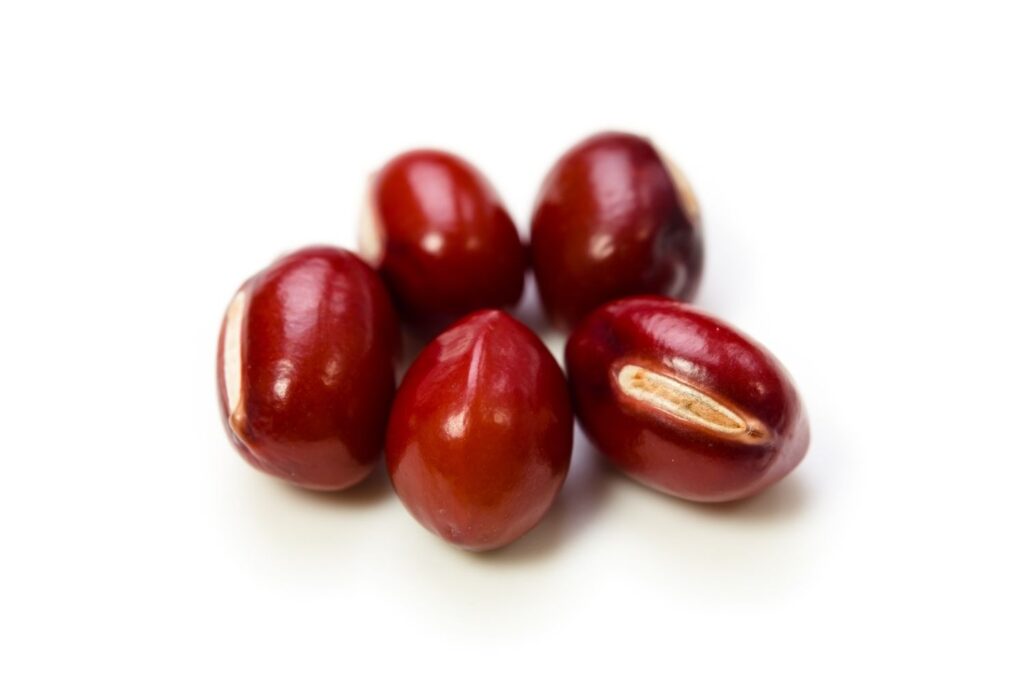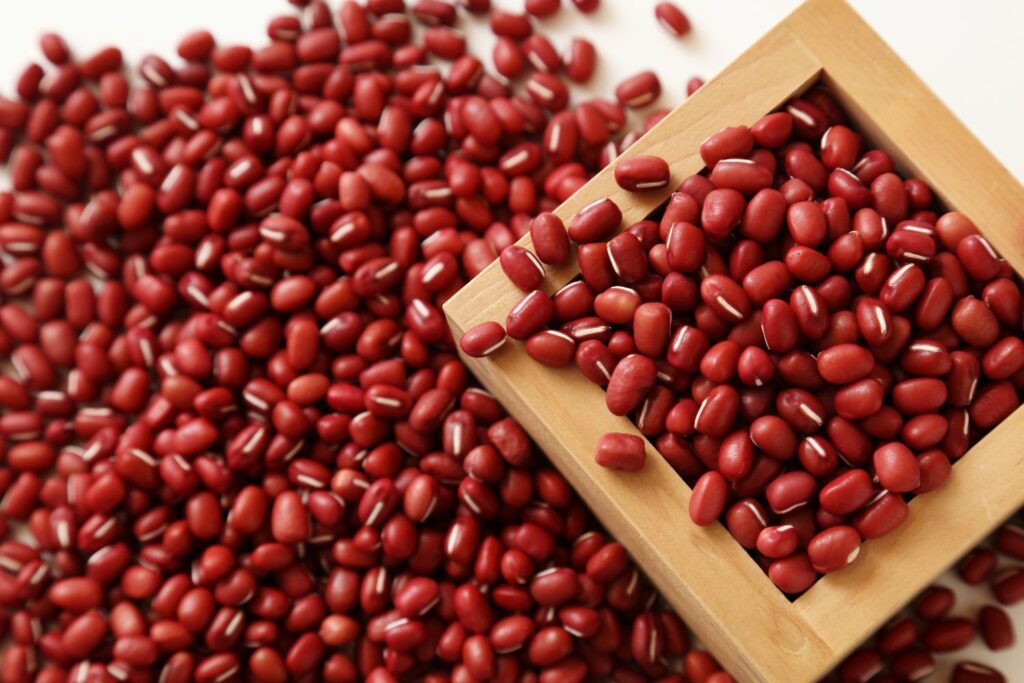Ready to explore something cool in desserts? Meet azuki beans—these little beans are naturally sweet and have been a favorite in Japanese treats for a long time. Let’s shake up your usual dessert ideas!
From the ancient origins of these small, sweet red beans to their modern-day role in delectable confections, there’s a fascinating story waiting to be discovered.
Join us as we uncover the secrets behind turning humble legumes into sought-after dessert ingredients, explore the health benefits they offer, and witness the perfect blend of tradition and innovation.
Get ready to indulge your taste buds and satisfy your curiosity as we journey into the enchanting realm where tradition meets taste in the most unexpected of ways.
Origins of Azuki Beans
Azuki beans, integral to Japanese cuisine, originated in East Asia, where they’ve been cultivated for thousands of years. As you delve into the world of Japanese desserts, understanding the roots of these beans empowers you to appreciate not just the flavors but the history and culture they carry.
These small, red beans weren’t only a source of nutrition but also became a staple in traditional Japanese sweets, known as wagashi.
You’ll find that azuki beans are more than just an ingredient; they’re a bridge to the past. Farmers in ancient East Asia harnessed the fertile lands and changing seasons to grow azuki beans, mastering techniques that yielded the finest crops. This dedication to perfection is something you can harness in your culinary explorations.


Sweetening Desserts Naturally
Often, chefs incorporate azuki beans into desserts to naturally sweeten them without relying on processed sugars. This technique not only enhances the flavor but also gives you control over the healthfulness of your treats.
Azuki beans, with their inherently sweet profile, offer a unique way to add depth and richness to desserts without the spike in blood sugar that comes from traditional sweeteners.
You might wonder how you can use these beans in your own kitchen. It’s simpler than you think. Start by cooking the beans until they’re soft and sweetened with a touch of natural sweeteners like honey or agave.
Once they’re ready, mash them into a smooth paste, known as anko, which you can then use as a filling or topping in various desserts, from cakes to mochi to ice cream.
This approach not only reduces your consumption of refined sugars but also introduces more fiber and nutrients into your diet, making your dessert indulgence a bit healthier.
By choosing azuki beans as a natural sweetener, you’re taking a step towards more mindful, health-conscious eating habits. Plus, you’ll discover a new layer of flavor that’ll make your desserts stand out.
Popular Azuki-Based Sweets
Having explored how chefs use azuki beans to naturally sweeten desserts, let’s now look at some popular sweets that feature this versatile ingredient. You’re in control of your culinary adventure, and understanding these treats will enrich your dessert choices.
First up is Anko, the foundation of many Japanese sweets. It’s a sweet red bean paste, and you’ll find two main types: Koshian, smooth and without bean skins, and Tsubuan, chunky with intact beans. Your preference dictates the texture of your dessert, so choose wisely.
Next, let’s talk about Taiyaki, a fish-shaped cake filled with Anko. You’ll enjoy the contrast between the crispy outer layer and the soft, sweet filling. It’s a delightful experience you can dictate by selecting the right filling-to-cake ratio.
Lastly, Daifuku is a must-try. It’s a mochi (glutinous rice cake) stuffed with Anko. The chewy exterior paired with the creamy sweetness inside offers a textural balance that’s purely blissful. Control the sweetness level by opting for more or less Anko filling.
Cooking Techniques Explained
To master the art of incorporating azuki beans into your desserts, understanding the specific cooking techniques involved is key. You’ll need to soak the beans overnight to soften them, which reduces cooking time and ensures they cook evenly.
After soaking, drain them and cover with fresh water in a pot. Bring to a boil, then lower the heat and simmer until they’re tender. This process might take up to an hour, but keep an eye on them; you don’t want them too mushy.
Next, you’ll tackle the sweetening stage. Drain the cooked beans and return them to the pot, adding sugar. The sugar amount can vary depending on your taste and the dessert you’re planning.
Cook this mixture on low heat, stirring constantly to avoid burning, until the beans absorb the sugar and the mixture thickens.


Health Benefits of Azuki Beans
Azuki beans aren’t just a versatile ingredient in Japanese desserts; they also offer a range of health benefits that can boost your well-being.
Loaded with fiber, they’re a fantastic choice to aid in digestion and help you maintain a healthy weight. They keep you feeling full longer, so you’re less tempted to snack on less nutritious options.
Rich in protein, azuki beans support muscle repair and growth, making them a great addition to your diet if you’re looking to stay fit and active.
They’ve got a low glycemic index too, which means they can help manage blood sugar levels, offering a steady energy source without the spikes associated with other sweet treats.
You’ll also find a wealth of vitamins and minerals in these small but mighty beans. They’re packed with antioxidants that fight off free radicals, reducing your risk of chronic diseases and keeping your skin looking youthful.
Plus, their iron content can help ward off anemia, ensuring you’ve got the energy you need to tackle your day.
Incorporating azuki beans into your diet isn’t just about indulging in delicious desserts; it’s a step towards taking control of your health, offering a balance of taste and nutrition that can enhance your lifestyle.
Conclusion
So, you’ve journeyed through the world of azuki beans, from their origins to their sweet role in Japanese desserts. You’ve discovered how these little red beans naturally sweeten treats and learned about popular azuki-based sweets.
We’ve also demystified cooking techniques and unveiled their health benefits. Now, armed with this knowledge, you’re ready to explore the delightful sweetness of azuki beans in your own kitchen.
However, it’s important to note that not everyone may enjoy the taste of azuki beans in desserts. Some people may find their flavor too strong or their texture not to their liking. But hey, taste is subjective, and that’s what makes food exploration so exciting!
If you have a different opinion or simply want to share your thoughts on azuki beans, we’d love to hear from you. Leave a comment below and let’s continue the conversation.
Who knows, your perspective might just inspire someone else to try or avoid these sweet red beans in their desserts.
So go ahead, let these beans inspire your next dessert creation, but remember, there’s always room for differing tastes and opinions. Happy cooking and bon appétit!




Konnichiwa! (Hello!) I'm Pat Tokuyama, a Japanese tofu cookbook author, who travels for music, food, and adventure. If you like Japanese tea, checkout some of the newestorganic japanese tea, matcha bowls and noren and more!
** Curious about the Plant Based Japanese Cooking Club? ** Learn more here!